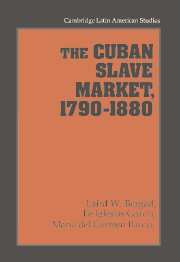Book contents
- Frontmatter
- Contents
- Tables and figures
- Preface and acknowledgments
- Glossary
- 1 Introduction: Prices and the historiography of slavery
- 2 Sources and methods of data collection
- 3 The development of African slavery and Cuban economic history
- 4 The price structure of the Cuban slave market, 1790–1880
- 5 Regional variations in the Cuban slave market: Havana, Santiago, and Cienfuegos
- 6 Coartación and letters of freedom
- 7 Conclusions and comparative perspectives
- Appendix A Nominal and real slave prices using international price indexes
- Appendix B Statistical data base on the Cuban slave market
- Bibliography
- Index
- CAMBRIDGE LATIN AMERICAN STUDIES
4 - The price structure of the Cuban slave market, 1790–1880
Published online by Cambridge University Press: 22 March 2010
- Frontmatter
- Contents
- Tables and figures
- Preface and acknowledgments
- Glossary
- 1 Introduction: Prices and the historiography of slavery
- 2 Sources and methods of data collection
- 3 The development of African slavery and Cuban economic history
- 4 The price structure of the Cuban slave market, 1790–1880
- 5 Regional variations in the Cuban slave market: Havana, Santiago, and Cienfuegos
- 6 Coartación and letters of freedom
- 7 Conclusions and comparative perspectives
- Appendix A Nominal and real slave prices using international price indexes
- Appendix B Statistical data base on the Cuban slave market
- Bibliography
- Index
- CAMBRIDGE LATIN AMERICAN STUDIES
Summary
Between 1790 and 1867 over 780,000 African slaves were imported to Cuba making the island the greatest slave-importing colony in the history of the Spanish empire and the center of the nineteenth-century slave trade to the Caribbean. The African trade did not exclusively determine the demographic and economic characteristics of the Cuban slave market because it was supplemented by reproduction, although birth and death rates and overall rates of increase or decrease among Cuban slaves are largely unknown. Published colonial census reports and slave trade data indicate quite clearly that the Cuban slave population did not experience natural demographic expansion. Nevertheless, the sale of Cuban-born slaves had a significant impact on the slave market especially after 1845 when the majority of slaves sold in our sample were born in Cuba.
This chapter's analysis of the Cuban slave market is based on 23,022 total sales (ventas reales) recorded between 1790 and 1880: 9,401 were from Havana; 10,069 were from Santiago; and 3,552 were from Cienfuegos. Although we have a complete time-series record from Havana, data are not available for Santiago until 1816, and it is only beginning in 1830 that slave sales were recorded in Cienfuegos. Thus, the conditions of the islandwide Cuban slave market between 1790 and 1816 described below were exclusively determined by information from Havana. These data can be used as reliable indicators of conditions on the overall market for slaves in this period because 90 percent of all slaves officially imported entered through the colonial capital.
- Type
- Chapter
- Information
- The Cuban Slave Market, 1790–1880 , pp. 38 - 78Publisher: Cambridge University PressPrint publication year: 1995
- 1
- Cited by

